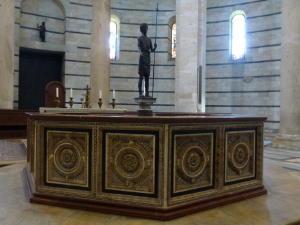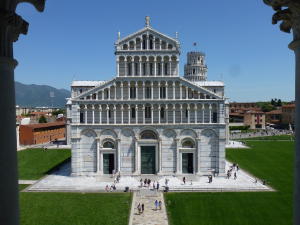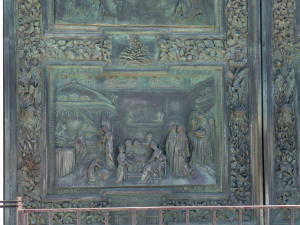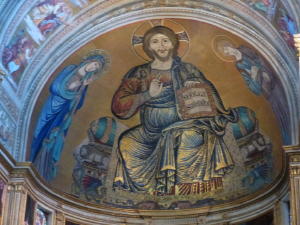|
|
|
|
Train from Florence to Pisa
|
Painting by American artist Keith Haring in 1989. He brought
NYC graffiti into the mainstream. This painting is a celebration
of diversity, chaos and liveliness of our world.
|
Corso Italia - the main shopping street in Pisa
|
|
|
|
|
|
|
Piazza della Vettovaglie
Note the curve in the building.
|
Open air produce market on Piazza della
Vettovaglie.
|
|
|
|
|
Zucchini flowers are delicious when breaded and served
as an appetizer.
|
|
The Duomo and Baptistry
The buildings are constructed from bright white marble
in a style called Pisan Romanesque which is lighter and
more elegant than traditional Romanesque.
|
|
|
|
|
Camposanto Cemetery
The site has been a cemetery since ancient times. The open
air courtyard is surrounded by an arcade with intricately
carved arches.
|
The courtyard's grass grows on special dirt
shipped here by returning Crusaders from Jerusalem's Mount
Calvary where Christ was crucified. It is said to turn a body
into bones in a single day!
|
The arcade floor is paved with the coats of arms of some
600 departed Pisans.
|
|
|
|
|
|
Displayed in the arcade are dozens of ancient
Roman sarcophagi.
|
The brick walls are covered with traces of fresco.
|
|
|
|
|
|
|
|
|
Leaning Tower of Pisa
The Tower is nearly 200 feet tall and 55 feet wide. It
is currently leaning at a five degree angle (15 feet off
the vertical axis.) after years of work. to stablize it.
|
|
|
|
|
|
The Tower started to lean almost immediately
after construction began in 1173. It was built over two centuries
by at least three different architects. Each tried to correct
the leaning problem, once at the fourth story and once at
the belfry on top.
|
To climb to the top of the Tower, you wind
your way up along a spiraling staircase that has been worn
by previous tourists! Due to the slant of the tower, the 294
steps are also slanted and the marble can be slippery.
|
Looking down through the center of the tower
and the bells in the belfry.
|
|
|
|
|
|
View of the Duomo and Baptistry from the
top of the Tower
|
It is said that Galileo dropped objects
off the Tower in attempts to understand gravity.
|
|
|
|
|
|
|
|
Pisa's Baptistry is Italy's biggest. The building was begun
in 1153. It was actually built in three sections - the Romanesque
blind arches at the base in 1153, the ornate Gothic spires
and pointed arches in the middle in 1250 and the Renaissance
dome in the 15th century.
|
The Baptistry is 180 ft. tall. It actually
leans about 6 feet.
|
|
|
|
|
Interior of Baptistry
The acoustics are so good in here that sound echoes for
a good 10 seconds. This is due to the 250 foot wide dome.
It is said that a priest standing at the baptismal font
can sing three tones within the 10 seconds and make a chord,
thus harmonizing with himself.
|
Nicola Pisano's Pulpit, built in 1260, is 15 feet tall.
The speaker's platform stands on columns that rest on the
backs of animals, representing Christianity's triumph over
paganism.
|
The relief panels are scenes from the life
of Christ done in white Carrara marble and framed by dark
rose colored marble.
|
 |
 |
|
Baptismal Font
Baptismal fonts are traditionally octagons. The shape suggests
a cross and eight sides represent the 8th day of Christ's
ordeal when he was resurrected. The font has plenty of space
for baptizing adults by immersion, plus four wells for dunking
babies. The sides are carved with inlaid multicolored marble
and feature circle in a square patterns indicating the interlocking
of heaven and earth.
|
Duomo
This huge Romanesque cathedral is artistically more important
than its more famous bell tower. It was begun in 1063 and
financed by booty ransacked from the Muslim-held capital
of Palermo, Sicily.
|
Bronze Doors of St. Ranieri
Designed by Bonanno Pisano around 1186.
|
 |
|
|
| |
|
|
|
|
|
|
|
The 320 foot nave of the Duomo was the longest
in Christendom when it was built.
|
One of the side altars.
|
Galileo's Lamp
Hanging from the ceiling is the one that caught teenage
Galileo's attention one day in church. Someone left a door
open and a gust of wind set the lamp swinging. Galileo timed
the swings and realized the the burner swung back and forth
in the same amount of time regardless of how wide the arc.
|
|
|
|
|
Pulpit
Carved out of white Carrara marble by Giovanni Pisano (son
of Nicola) between 1301 and 1311. It was the last, biggest
and most complex of the four pulpits by the Pisano father
and son team. 400 intricately sculpted figures smother the
pulpit. The relief panels are actually curved and tell the
story of Christ's life.
|
Four of the pulpit's support columns are
statues. This one is Hercules, standing nude and holding his
club and lion skin.
|
Lady Church suckles the babies of the Old
and New Testaments.
|
|
|
 |
|
|
|
The mosaic (c.1300) shows Christ as the
Ruler of All (Pantocrator) between Mary and John the Evangelist.
|
|
